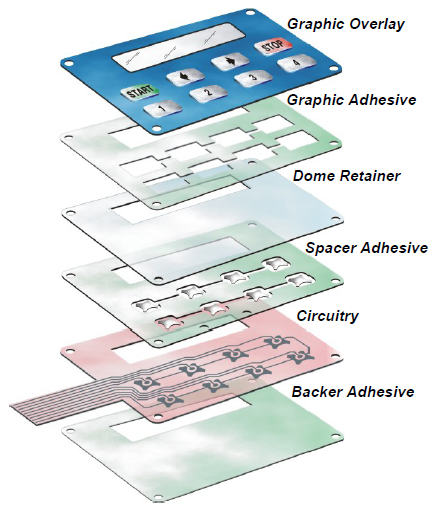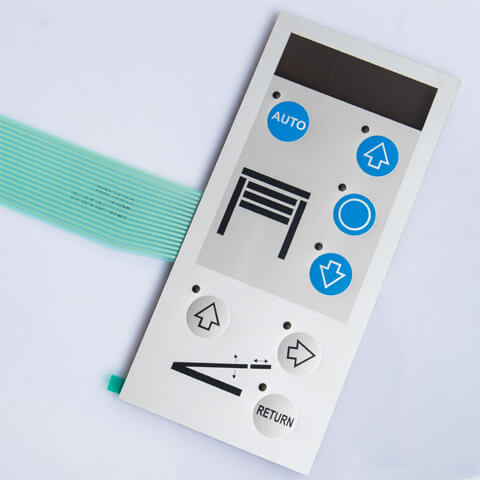Membrane Switch Over Modern Technology: The Secret to Trustworthy and Cost-efficient Interfaces
Membrane layer switch modern technology has arised as a pivotal element in the style of individual interfaces, supplying both reliability and cost-effectiveness throughout a varied variety of applications. Its robust construction guarantees resistance to environmental difficulties, while the versatility in design enables for tailored options that meet details industry requirements. As we explore the complex benefits of membrane buttons, their potential for technology questions regarding future applications and advancing fads. What does the following chapter hold for this technology in an increasingly digital landscape?
Understanding Membrane Switch Over Technology
Membrane layer switch modern technology is an extensively made use of user interface option in various digital devices, supplying a seamless blend of performance and design. This technology incorporates several layers of materials, usually consisting of a graphic overlay, spacer layer, and a circuit layer. The visuals overlay shows the user interface aspects, while the spacer layer separates the circuit layer from the overlay till an individual activates a switch.
When stress is put on the overlay, the circuit layer finishes the electric circuit, sending a signal to the tool. This system allows for various configurations, including responsive responses and backlighting choices, improving individual interaction. Membrane layer buttons are commonly made using resilient materials such as polyester or polycarbonate, making certain longevity and resistance to environmental variables like wetness and dirt.
The flexibility of membrane layer switches allows their application in diverse markets, including medical devices, consumer electronics, and commercial controls. Their small layout enables combination into space-constrained environments, offering an efficient user interface without endangering visual charm. Understanding the ins and outs of membrane switch modern technology is important for makers and developers looking for to produce reputable and reliable human-machine interfaces.
Secret Benefits of Membrane Layer Switches
While different user interface options exist, membrane switches offer unique benefits that make them a recommended option in many applications. Among the primary advantages is their longevity; membrane switches are made to stand up to severe environmental conditions, including dampness, dirt, and temperature variations, making sure long-lasting efficiency. This durability considerably decreases the need for regular replacements, therefore lowering total upkeep costs.

In addition, membrane layer buttons are light-weight and compact, making them ideal for applications where room is limited. Their inconspicuous style adds to a streamlined appearance without jeopardizing performance.
Cost-effectiveness is additionally a notable advantage, as the production process for membrane changes often tends to be cheaper compared to conventional mechanical switches. This cost, integrated with their dependability and convenience of installation, settings membrane changes as a functional remedy for a large range of sectors looking for efficient and effective user interfaces.
Applications Throughout Various Industries
How do membrane layer buttons adjust to the diverse needs of various markets? Membrane switch innovation is progressively acknowledged for its versatility, making it suitable for a vast array of applications throughout multiple industries.
In consumer electronic devices, membrane layer switches give a small service try this site for remote controls and home appliances, enhancing individual experience with user-friendly design. Additionally, the commercial industry leverages membrane buttons for equipment control panels, gaining from their resistance to extreme atmospheres, such as wetness and dirt.
Army and aerospace applications also use membrane layer switches for their dependability and ability to stand up to severe problems, making certain operational effectiveness in essential circumstances. The food and beverage market embraces these switches for automated systems, where cleanliness and ease of operation are critical (membrane switch). Ultimately, membrane switches are tailored to meet the special needs of each industry, confirming their necessary duty in modern-day innovation interfaces
Style and Customization Options

In the world of membrane button modern technology, design and customization alternatives play a critical duty in boosting capability and user interaction. These switches can be tailored to meet specific operational needs and aesthetic preferences, making them functional components in different applications.
One of the main customization choices is the layout of the button itself, which can be designed to fit special customer interfaces and ergonomic factors to consider. By readjusting the shape, dimension, and arrangement of buttons, suppliers can develop instinctive styles that promote ease of usage. Additionally, the consolidation of different shades and graphic overlays enables branding and improved exposure, guaranteeing that customers can promptly recognize features.
Moreover, membrane layer buttons can be crafted with different tactile responses mechanisms, such as raised switches or audible clicks, to boost the individual experience. Various products can additionally be picked for sturdiness and explanation environmental resistance, resolving factors such as dampness, temperature level fluctuations, and chemical exposure.
Ultimately, the substantial design and customization choices offered in membrane layer button modern technology equip organizations to produce tailored services that not just satisfy practical needs however additionally line up with their branding and operational demands.

Future Fads in Membrane Layer Switches
As membrane switch modern technology continues to evolve, future fads are progressively concentrated on improving More Bonuses individual experience and incorporating innovative performances. One significant trend is the integration of touch-sensitive and capacitive technologies into typical membrane layer switches. This advancement allows for even more intuitive interface, giving responsive comments while keeping a smooth style.
One more emerging fad is the use of eco-friendly products, driven by the growing need for sustainable production practices. Manufacturers are looking for to decrease their carbon footprint by utilizing recyclable substrates and low-impact inks, aligning with worldwide sustainability goals.
Furthermore, the increase of the Web of Things (IoT) is motivating the incorporation of clever attributes right into membrane switches. Boosted connectivity alternatives will make it possible for gadgets to communicate with each other, permitting smooth combination right into wider systems.
Furthermore, developments in printing modern technologies, such as electronic printing, are permitting better design flexibility and customization. This allows producers to produce elaborate designs and vibrant shades cost-effectively.

Verdict
In conclusion, membrane layer switch modern technology represents an essential development in individual interface layout, using considerable benefits in resilience, modification, and cost-effectiveness. As improvements proceed to emerge, specifically in touch-sensitive user interfaces and lasting materials, the possibility for membrane switches over to enhance individual experience and performance remains encouraging.